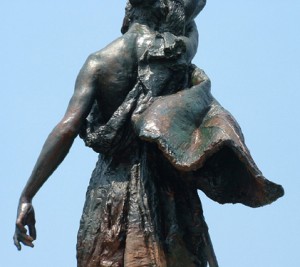Women of the Southern Confederacy
in Jacksonville’s Confederate Park
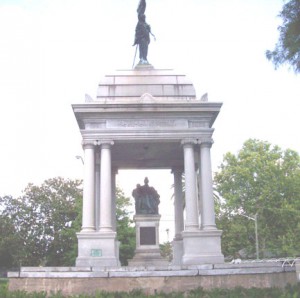
Thousands of elderly Confederate veterans camped in tents in Jacksonville’s Springfield Park and Dignan Park on May 6-8, 1914 as part of the 24th annual United Confederate Veterans Reunion. The city later commemorated this event by changing the name from Dignan to Confederate Park on October 15, 1914.
The events leading to the park’s renaming began during a Florida Reunion of the United Confederate Veterans (U.C.V.) in 1900, when its members discussed the possibility of creating a memorial to the Women of the Confederacy. The discussions continued for several years, until the Florida Division of the U.C.V. resolved in 1909 to build the memorial. Its members raised $12,000 toward the cost of a monument, with the remaining $13,000 eventually appropriated by the Florida Legislature. The U.C.V. chose Jacksonville as the site for their twenty-fourth annual reunion in 1914, and Dignan Park as the home for the Memorial Monument.
The U.C.V. signed a contract with the McNeel Marble Company of Marietta, Georgia in February 1912 for the design and installation of the monument, consisting of a granite rotunda and bronze sculptures, at a total cost of $25,000. The company commissioned Allen Newman (1875-1940) to create the sculptures.. Although Newman was a Yankee from New York, he was one of the nation’s leading sculptors of the time, and his selection reveals the Monument committee’s desire to get the most prestigious artist possible for the memorial. Newman created many monumental patriotic memorials throughout the US. including “The Triumph of Peace” (Atlanta); monuments to Henry Hudson (New York), General Sheridan (Scranton, PA), Joel Chandler Harris (Altanta); the figures “Day” and “Night” at Harriman National Bank (New York); the statues of General Oates (Montgomery, AL) and General Sterling Price (Keytesville, MO); and the monumental figures in the North Façade of Exhibit Palaces at the 1915 Panama-Pacific International Exposition in San Francisco. His two most famous statues are the World War I soldier, “The Doughboy” (1920-1921) and the Spanish-American War soldier, “The Hiker” (1904), casts of which were reproduced in several cities across America. The building permit was issued in July 1912, and the McNeel Marble Company started constructing the 47-foot high rotunda in Dignan Park soon thereafter.
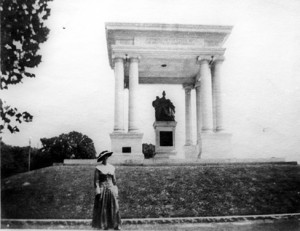
After Allen Newman shipped the bronze sculptures from New York in March 1915, they were installed at the park by the McNeel Marble Company. Placed within the open rotunda was a six-foot high grouping of a young mother seated on a large pedestal, with an open book in her lap. Her arms encircle a child standing on each side – her young son, who stares attentively at the book, and her little daughter, who gazes openly at the viewer.
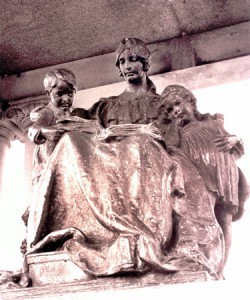
In describing his work, Mr. Newman wrote:
“When the Greeks wished to honor a divinity, they made a statue of note and built a temple around it. …and I have approached the subject from this attitude of reverence. …in brief the group represents the Woman of the South instructing future generations, as well as showing her the most privileged guardian of the home ties.”

Engraved at the top of rotunda on the west side is the true and historically accurate name of the this beautiful monument, “A Tribute to the Women of the Southern Confederacy.”
Atop the outer dome of the rotunda, workers placed the other allegorical bronze sculpture: the heroic figure of a young woman. Clothed in Grecian drapery, she stands over thirteen feet high and clasps the fallen banner – a half-furled Confederate flag. Though the steps lead up to the rotunda from the south, both the upper and lower sculptures face west, into the setting sun. A bronze plaque mounted on the pedestal within the rotunda reads:
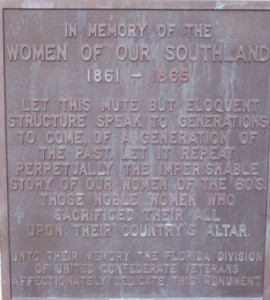
In Memory of the Women of Our Southland, 1861-1865.
Let this mute but eloquent structure speak to generations to come, of a generation of the past. Let it repeat perpetually the imperishable story of our women of the 60’s. Those noble women who sacrificed their all upon their country’s altar. Unto their memory, the Florida Division of the United Confederate Veterans affectionately dedicates this monument.
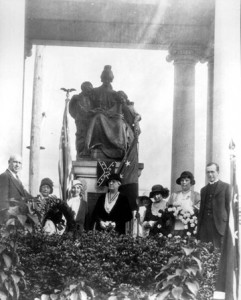
The formal dedication took place on October 26, 1915, amid fanfare that included a large parade through downtown Jacksonville. Large Confederate flags completely draped the monument prior to the unveiling, which was preceded by several speeches, including an oration by U.S. Senator Duncan Fletcher. General Benjamin Partridge – whose granddaughter Jessie unveiled the monument – then presented the memorial to the City on behalf of the Florida Division.
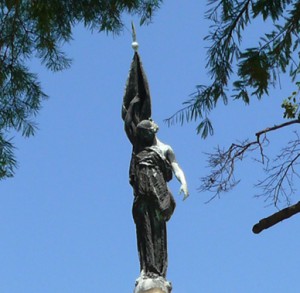
An original postcard (pre-construction) for the monument featured a grossly out-of-scale figure on the top,
replaced in the final version with Newman’s graceful but heroic Southern woman. In 2007 the Springfield Improvement Association and Woman’s Club undertook the restoration of the Monument to Women of the Southern Confederacy, which is nearing completion. Sculptor Joe Segal has supervised the cleaning of the statues, and Pedroni’s Cast Stone is doing the restoration of the marble and granite stonework.
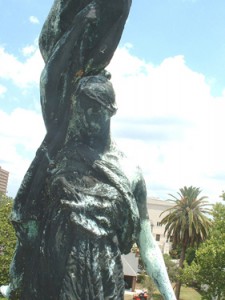
ove photos show the poor condition of the sculptures before restoration,
and the photo below shows the beautiful finished work.
